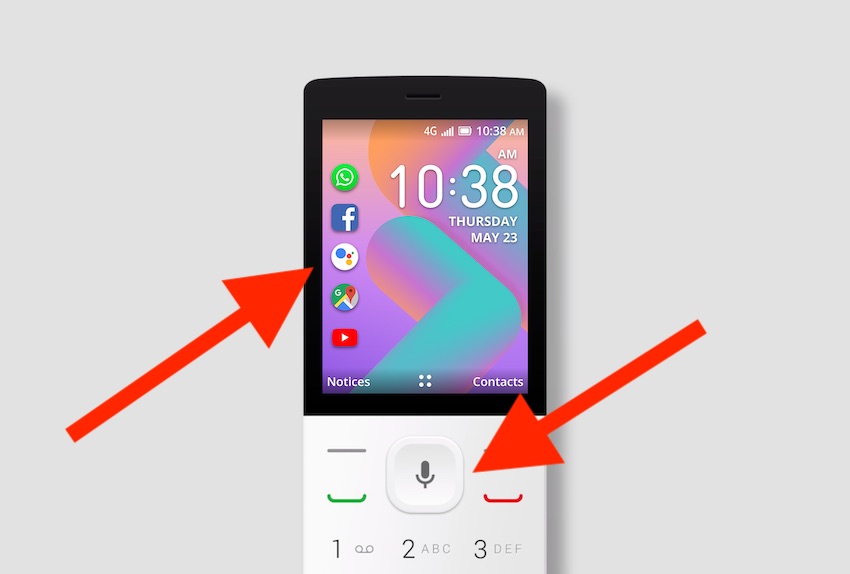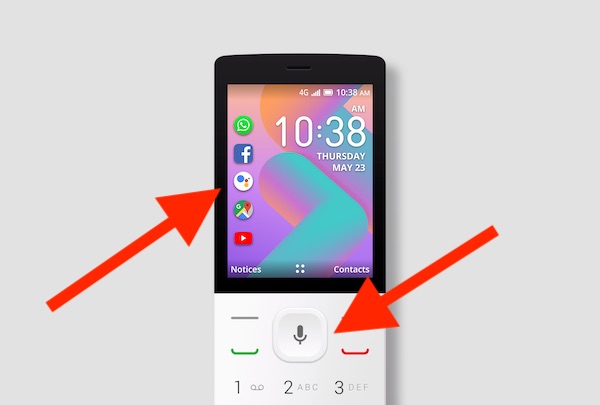Google Assistant on Feature Phones is Taking Off and Should Change the Way You Think About Voice Assistant Growth – EXCLUSIVE

Image Source: KaiOS (arrows added by Voicebot)
At the Google for India event on December 2017, it was announced that Google Assistant would arrive on the JioPhone in 2018. This was notable because JioPhone is a feature phone that costs about US $23 and not a smartphone where voice assistants are common. Voicebot reported at the time:
“Voice is ideal for low functionality devices like feature phones. The lack of a high-resolution screen and robust mobile apps means that Google Assistant can provide access to information, services, and applications that wouldn’t otherwise be available to these users. Voice access may even make feature phones more desirable by slightly narrowing the feature gap with smartphones.”
The JioPhone announcement was followed by the introduction of the WizPhone with Google Assistant in Indonesia in December 2018. WizPhone is also a feature phone, but with an even lower price point. A Google blog post by Randy Jusuf, managing director, Google Indonesia, said, “WizPhone is the first feature phone made by Indonesians that will have the Google Assistant built in and it will retail at less than $10.” In covering that news, I asked a simple question.
Can the presence of a voice assistant transform a feature phone into a smartphone?
Voice Assistants Make Feature Phones Smart
It appears that the answer is yes. There are now over 100 million feature phones that include Google Assistant with the mobile operating system KaiOS which is common to many of these devices. According to Google’s Austin Chang, “It is the same Google Assistant as on Pixel. The only difference is what the device implementations are. Weather, transit information, [and] doing some device Actions. It is the same assistant.”
Chang is Director, Product Management and Google Assistant Head of Automotive and Emerging Markets says he is focused on the next billion users of Google. The company already has dominant global consumer reach through 2.5 billion Android smartphone users. However, with more than 85% of mobile OS market share, there is little room to grow as smartphone sales growth subsides. Consumers without smartphones aren’t likely to access the internet (and Google services) by becoming a new laptop owner. They don’t have access because the cost of electronic devices is a barrier. Feature phones are a connected device that many of these consumers own even if that initially seemed like an unlikely option for robust internet access.
Google CEO Sundar Pichai outlined the next billion user strategy in a 2015 blog post saying, “We’d like to help get these next billion Indians online—so they can access the entire web, and all of its information and opportunity.” At the time, Google thought that “cheaper smartphones” was the likely solution to providing wider internet access. The better solution has turned out to be making “cheap” feature phones smarter by simply adding Google Assistant. Austin Chang commented:
“On the lower end phones we saw unique usage. It is almost like the first time they were accessing information on the internet. When we enabled this on feature phones we saw usage explode. These are not proficient internet users. They are used to it just being a telephone. They are now using the devices to find information and entertainment on the internet. We are now seeing Google Assistant as the easiest way to access the internet.”
The Three V – Voice, Video & Vernacular
Chang’s product strategy for the next billion users has focused around three Vs: voice, video, and vernacular. “They can just say what they want,” says Chang. “They don’t need to learn an app ecosystem or how to download and use apps. They can just ask for it.” This is where Google Assistant becomes core to the strategy. He continued, “They can understand video. They can quickly understand and access the content they want. Vernacular [means] they can do this in their local language.” He added that the Google Assistant team has done a lot of work around understanding how these consumers speak naturally and the dialects they use, including 10 Indic languages. These factors combined are making Google Assistant on feature phones a “gateway to information.”
Emerging Market Engagement Growing 75% Faster
There also appears to be momentum behind these efforts. Chang indicated that Google’s global user engagement rose by four times last year, but that figure rose seven times in emerging markets.
“We are taking a different approach…by going to the platforms that users are familiar with and in their natural language offering information and services that are relevant to them on a daily basis. It is almost counter to what you would expect. I remember using the old Nokia 8200 and [wondering how] that same form factor, can this be relevant nowadays. These are not touch screens. Voice is a natural way for these users to actually access information other than just calling or texting.
“Even low-end smartphones are actually more browsing and consumption-based. Because users haven’t had access to the internet before to watch viral videos or get cricket scores. We are trying to identify these patterns and behaviors.”
Chang indicated that they are investing in Google Actions specifically for these users and have had initial success with translation and transit apps. Google is not building these Actions but instead encouraging third-party developers to provide more voice apps for feature phone users.
The Cloud and AI Change the Smart Equation
Feature phones have experienced several consecutive quarters of growth while smartphone sales have been flat or declined according to Counterpoint’s Market Monitor from late 2018. The low-end of the smartphone market, in terms of price point, is the one remaining segment that is still seeing growth. Voice assistants are a tool for both segments to compensate for more limited hardware specs while matching a core feature of higher-priced offerings. An example arrived today in the U.S., with the $139 Nokia 2.2 that comes with a dedicated Google Assistant button.
Value segment Chinese smartphone maker Coolpad announced at Mobile World Congress in 2018 that it was adding Amazon Alexa to two of its low-priced smartphones so these trends don’t exclusively point to wider Google Assistant adoption. However, it appears almost all of the activity today in adding voice assistants to the least expensive smartphones and to feature phones is centered around Google Assistant. The user data from Google suggests there is clear value for consumers when combining a low price-point device with broader access to internet-based services so the trend is likely to continue.
When asked whether a feature phone with Google Assistant is suddenly a smartphone, Austin Chang responded, “It depends on what people believe is a smartphone. Is it lots of RAM and a high-res camera? Then, these [feature phones] are very primitive smartphones. To these users, it is absolutely a smartphone. It’s life-changing.”
Follow @bretkinsella Follow @voicebotai









